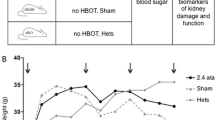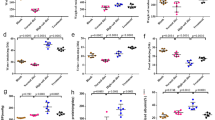Abstract
Background
Oxidative stress plays a role in the mechanism of chronic kidney disease (CKD), and antioxidant regimes are regarded as promising treatment modalities. We compared the effects of cilazapril, simvastatin, and hyperbaric oxygen (HBO) treatment on proteinuria and on oxidative stress in adriamycine (ADR)-induced proteinuria.
Methods
Seventy male Sprague–Dawley rats were housed, and 60 were injected with ADR to induce nephrosis. After the stabilization of proteinuria, rats were treated for 6 weeks with simvastatin (n = 10, 4 mg/kg/day), cilazapril (n = 10, 10 mg/kg/day), HBO (n = 10, 2.8 athmosphere absolute, 90 min/daily), HBO + cilazapril (n = 10), HBO + simvastatin (n = 10), and vehicle (n = 10). After euthanization at 12 weeks, protein carbonyl (PCO), superoxide dismutase (SOD), and glutathion peroxidase (GPx) levels were analyzed from tissues. The histological alterations in the kidneys were determined by semiquantitative scoring.
Results
Protein carbonyl (PCO) levels were higher (p < 0.001), and the GPx and SOD levels were lower (p < 0.001 for all) in the nephrotic rats. Proteinuria was correlated to PCO (r = 0.483), GPx (r = −0.686), or SOD (r = −0.620) (p < 0.001 for all). Superoxide dismutase (SOD) (beta = −0.381, p = 0.02) and GPx (beta = −0.509, p < 0.001) were independently related to proteinuria levels. Both cilazapril and simvastatin significantly improved GPx, SOD, PCO, and proteinuria. When HBO was combined with either drug, the above markers further improved (p < 0.001). Both regimens caused distinct histological features, while the combination of HBO made much significant histological improvement.
Conclusion
Both cilazapril and simvastatin regimens improve oxidative stress and proteinuria, while the effects significantly increase with the combination of HBO treatment. HBO seems to be a candidate antioxidant strategy in glomerular diseases.



Similar content being viewed by others
References
Sies H. Oxidative stress oxidants, antioxidants. Exp Physiol. 1997;82:291–5.
Giordano FJ. Oxygen, oxidative stress, hypoxia, and heart failure. J Clin Invest. 2005;115(3):500–8.
Haugen E, Nath KA. The involvement of oxidative stress in the progression of renal injury. Blood Purif. 1999;17(2–3):58–65.
Modlinger PS, Wilcox CS, Aslam S. Nitric oxide, oxidative stress, and progression of chronic renal failure. Semin Nephrol. 2004;24(4):354–65.
Okuda S, Oh Y, Tsuruda H, Onoyama K, Fujimi S, Fujishima M. Adriamycin-induced nephropathy as a model of chronic progressive glomerular disease. Kidney Int. 1986;29(2):502–10.
Powis G. Free radical formation by antitumor quinones. Free Radic Biol Med. 1989;6(1):63–101.
Raats CJ, Bakker MA, van den Born J, Berden JH. Hydroxyl radicals depolymerize glomerular heparan sulfate in vitro and in experimental nephrotic syndrome. J Biol Chem. 1997;272(42):26734–41.
Barbey MM, Fels LM, Soose M, Poelstra K, Gwinner W, Bakker W, et al. Adriamycin affects glomerular renal function: evidence for the involvement of oxygen radicals. Free Radic Res Commun. 1989;7(3–6):195–203.
Yilmaz MI, Korkmaz A, Kaya A, Sonmez A, Caglar K, Topal T, et al. Hyperbaric oxygen treatment augments the efficacy of a losartan regime in an experimental nephrotic syndrome model. Nephron Exp Nephrol. 2006;104(1):e15–22.
Kusumoto Y, Takebayashi S, Taguchi T, Harada T, Naito S. Long-term prognosis and prognostic indices of IgA nephropathy in juvenile and in adult Japanese. Clin Nephrol. 1987;28(3):118–24.
Bader H, Meyer DS. The size of the juxtaglomerular apparatus in diabetic glomerulosclerosis and its correlation with arteriolosclerosis and arterial hypertension: a morphometric light microscopic study on human renal biopsies. Clin Nephrol. 1977;8(1):308–11.
Wehrmann M, Bohle A, Held H, Schumm G, Kendziorra H, Pressler H. Long-term prognosis of focal sclerosing glomerulonephritis. An analysis of 250 cases with particular regard to tubulointerstitial changes. Clin Nephrol. 1990;33(3):115–22.
Lowry OH, Rosebrough NJ, Farr AL, Randall RJ. Protein measurement with the folin–phenol reagent. J Biol Chem. 1951;193:265–75.
Levine RL, Garland D, Oliver CN, Amici A, Climent I, Lenz AG, et al. Determination of carbonyl content in oxidatively modified proteins. In: Packer L, Glazer AN, editors. Methods in enzymology, oxygen radicals in biological systems. California: Academic; 1990;186:464–78.
Sun Y, Oberley LW, Ying L. A simple method for clinical assay of superoxide dismutase. Clin Chem. 1988;34:497–500.
Paglia DE, Valentine WN. Studies on the quantitative and qualitative characterisation of erythrocyte glutathione peroxidase. J Lab Clin Med. 1967;70:158–69.
Foster LH, Sumar S. Selenium in health and disease: a review. Crit Rev Food Sci Nutr. 1997; 37:211–28.
Avissar N, Ornt DB, Yagil Y, Horowitz S, Watkins RH, Kerl EA, et al. Human kidney proximal tubules are the main source of plasma glutathione peroxidase. Am J Physiol. 1994;266:C367–75.
Whitin JC, Tham DM, Bhamre S, Ornt DB, Scandling JD, Tune BM, et al. Plasma glutathione peroxidase and its relationship to renal proximal tubule function. Mol Genet Metab. 1998;65:238–45.
Locatelli F, Canaud B, Eckardt KU. Oxidative stress in end-stage renal disease: an emerging threat to patient outcome. Nephrol Dial Transplant. 2003;18:1272.
Klahr S. Oxygen radicals and renal diseases. Miner Electrolyte Metab. 1997;23:140.
Nangaku M. The heat is on: an expanding role for hypoxia-inducible factors in kidney transplantation. J Am Soc Nephrol. 2007;18(1):13–5.
Eckardt KU, Bernhardt WM, Weidemann A, Warnecke C, Rosenberger C, Wiesener MS, et al. Role of hypoxia in the pathogenesis of renal disease. Kidney Int. 2005;Suppl (99):S46–51.
Palm F. Intrarenal oxygen in diabetes and a possible link to diabetic nephropathy. Clin Exp Pharmacol Physiol. 2006;33(10):997–1001.
Yilmaz MI, Saglam M, Caglar K, Cakir E, Sonmez A, Ozgurtas T, et al. The determinants of endothelial dysfunction in CKD: oxidative stress and asymmetric dimethylarginine. Am J Kidney Dis. 2006;47(1):42–50.
Vural A, Yilmaz MI, Caglar K, Aydin A, Sonmez A, Eyileten T, et al. Assessment of oxidative stress in the early posttransplant period: comparison of cyclosporine A and tacrolimus-based regimens. Am J Nephrol. 2005;25(3):250–55.
Washio M, Nanishi F, Okuda S, Onoyama K, Fujishima M. Alpha tocopherol improves focal glomerulosclerosis in rats with adriamycin-induced progressive renal failure. Nephron. 1994;68(3):347–52.
Okasora T, Takikawa T, Utsunomiya Y, Senoh I, Hayashibara H, Shiraki K, et al. Suppressive effect of superoxide dismutase on adriamycin nephropathy. Nephron. 1992;60(2):199–203.
Saran R, Novak JE, Desai A, Abdulhayoglu E, Warren JS, Bustami R, et al. Impact of vitamin E on plasma asymmetric dimethylarginine (ADMA) in chronic kidney disease (CKD): a pilot study. Nephrol Dial Transplant. 2003;18(11):2415–20.
Oter S, Edremitlioglu M, Korkmaz A, et al: Effects of hyperbaric oxygen treatment on liver functions, oxidative status and histology in septic rats. Intensive Care Med. 2005;31(9):1262–68.
Ozden TA, Uzun H, Bohloli M, Coskun O, Kilic D, Kisa U, et al. The effects of hyperbaric oxygen treatment on oxidant and antioxidants levels during liver regeneration in rats. Tohoku J Exp Med. 2004;203(4):253–65.
Li Y, Zhou C, Calvert JW, Colohan AR, Zhang JH. Multiple effects of hyperbaric oxygen on the expression of HIF-1 alpha and apoptotic genes in a global ischemia–hypotension rat model. Exp Neurol. 2005;191(1):198–210.
Wolf G, Ritz E. Combination therapy with ACE inhibitors and angiotensin II receptor blockers to halt progression of chronic renal disease: pathophysiology and indications. Kidney Int. 2005;67(3):799–812.
Fogo A, Yoshida Y, Glick AD, Homma T, Ichikawa I. Serial micropuncture analysis of glomerular function in two rat models of glomerular sclerosis. J Clin Invest. 1988;82(1):322–30.
Lapinski R, Perico N, Remuzzi A, Sangalli F, Benigni A, Remuzzi G et al. Angiotensin II modulates glomerular capillary permselectivity in rat isolated perfused kidney. J Am Soc Nephrol. 1996;7(5):653–60.
Fenster BE, Tsao PS, Rockson SG. Endothelial dysfunction: clinical strategies for treating oxidant stress. Am Heart J. 2003;146(2):218–26.
Yilmaz MI, Baykal Y, Kilic M, Sonmez A, Bulucu F, Aydin A, et al. Effects of statins on oxidative stress. Biol Trace Elem Res. 2004;98(2):119–27.
Haas MJ, Horani MH, Parseghian SA, Mooradian AD. Statins prevent dextrose-induced endothelial barrier dysfunction, possibly through inhibition of superoxide formation. Diabetes. 2006;55(2):474–79.
Sandhu S, Wiebe N, Fried LF, Tonelli M. Statins for improving renal outcomes: a meta-analysis. J Am Soc Nephrol. 2006;17(7): 2006–16.
Acknowledgments
The Research Center of GATA supported this study. We thank MERCK and ROCHE Research Laboratories for providing simvastatin and cilazapril. Mahmut Ilker Yilmaz benefited from EDTA-ERA Fellowships.
Author information
Authors and Affiliations
Corresponding author
Additional information
Alper Sonmez and Mahmut Ilker Yilmaz contributed equally to this article.
About this article
Cite this article
Sonmez, A., Yilmaz, M.I., Korkmaz, A. et al. Hyperbaric oxygen treatment augments the efficacy of cilazapril and simvastatin regimens in an experimental nephrotic syndrome model. Clin Exp Nephrol 12, 110–118 (2008). https://doi.org/10.1007/s10157-007-0017-2
Received:
Accepted:
Published:
Issue Date:
DOI: https://doi.org/10.1007/s10157-007-0017-2




